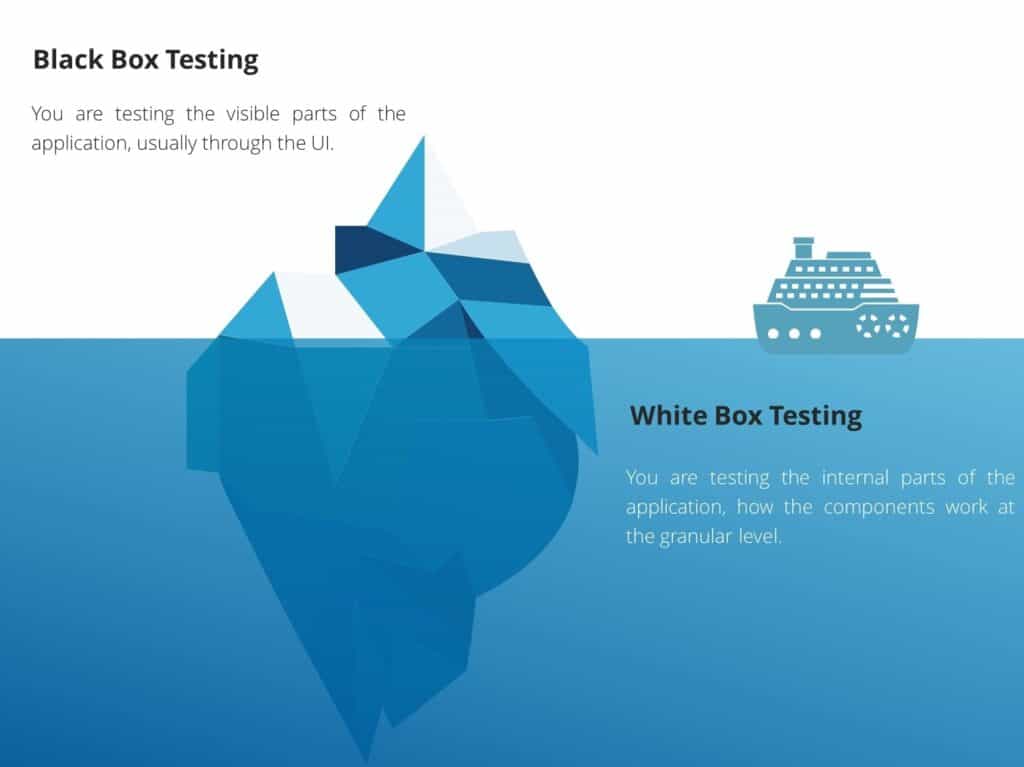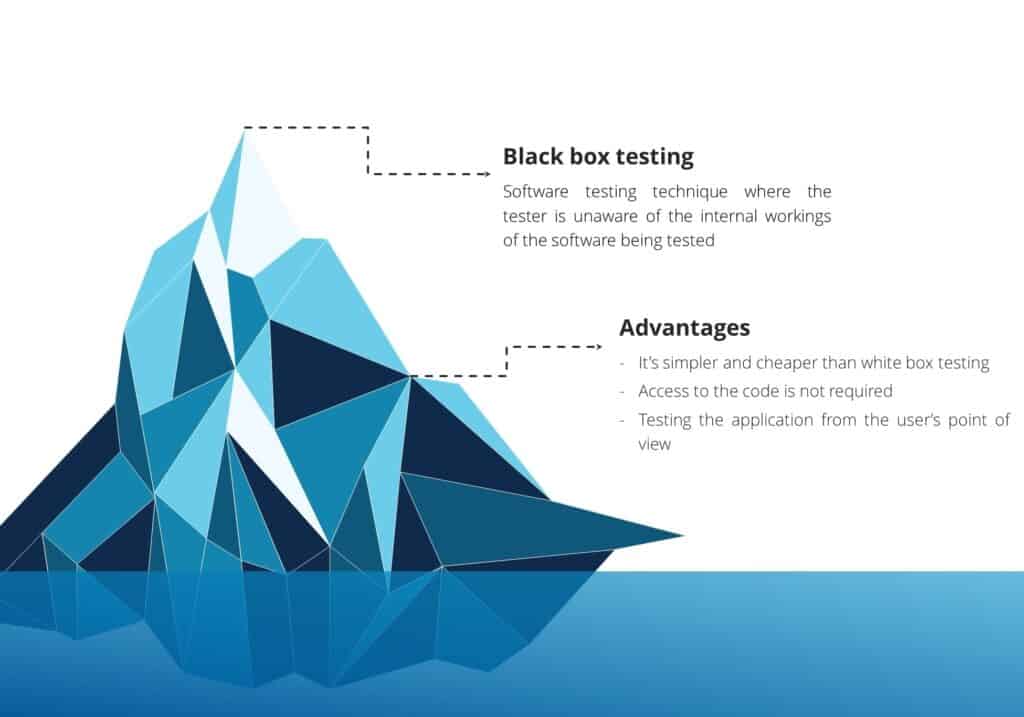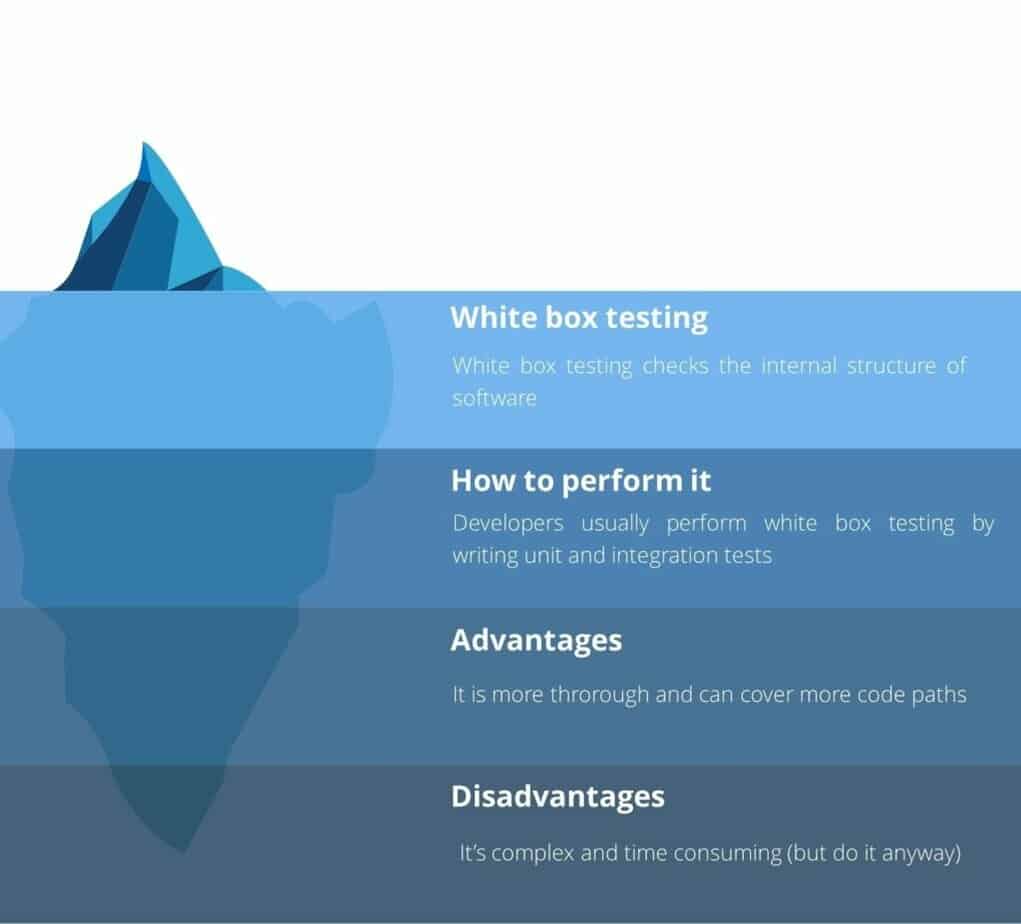Do you know why the Titanic was sunk?
Because of the iceberg.
As you know, the iceberg has two parts. One part is above water, and the other is below the water. Ultimately, the Titanic has fallen because of the invisible part. But that could have been avoided if the sailors had noticed the tip of the iceberg before it was too late.
The same is with the testing. You need to test the parts that the end-user sees. But also parts that are not visible to him. And this is where black box testing and white box testing come into play.
Black box testing is a technique where the tester does not know the internal workings of the code being tested. White box testing is a technique where the tester knows the internal workings of the code being tested. Black-box testing is considered more of a “functional” test, while white-box testing is considered more of a “structural” test.
So, the black box testing is the tip of the iceberg. And the white box testing is the invisible part of the iceberg. Let’s explore them in more detail.

What is black box testing?
Black box testing is a software testing technique where the tester is unaware of the internal workings of the software being tested. This approach is the most suited for the functional testing of the application. More importantly, the tester doesn’t need a robust development environment setup to start testing the software application. This means that the tester can test the software using minimal equipment.
The key benefit of black-box testing is that the tester does not need to know how the software functions under the hood. He also doesn’t need to have programming knowledge.
Black box testing is also known as functional testing.
How to perform black box testing
Black box testing is most often performed manually, but you can also automate the process using Selenium. While performing the black box testing, the tester is “blind” to the system’s internal workings. However, the tester should have a good understanding of the requirements and – to some extent – the system’s architecture under test.
The tester will then start the system with random input and then look for the output (or responses) that the system produces. This provides the tester with an indication as to whether the system is functioning as intended.
To perform a black box test, look at each of the four components:
- App functionality
- The business process within the application (aka flow)
- User interface
- Usability/User experience
When to use black box testing
You can perform this software testing method at any point in software development.
There are different types of black box testing:
- Functional testing – the testers are checking the application against the requirements.
- Non-functional testing – this testing type is related to performance, security, and usability.
- Regression testing – this is a process where you check that defects from a previous release are not reintroduced with the latest release.
To make the application the most secure, you may want to consider the use of black box testing for security testing. This is done without any knowledge of the internal design, thus emphasizing finding security flaws and vulnerabilities that are apparent to an external attacker. Because this type of testing involves inputting large amounts of random data, it can identify many defects and other weaknesses. This is known as penetration testing.
What are the advantages and disadvantages of black box testing?
The advantages include:
- It’s simpler and cheaper than white box testing.
- Testers are unaware of what the application looks like under the hood and cannot anticipate how it will react to the input. This ensures that testers are testing the application for the best-case scenario, ensuring that all of its features are used.
- Access to the code is not required.
- Can cover a large part of the application.
- Testing the application from the user’s point of view.
The disadvantages include:
- The testing might not uncover all bugs.
- It can be difficult to design tests since you don’t know the internals of the system.
- This testing might not cover all areas of the application.

What is white box testing?
White box testing is a testing technique where the tester is familiar with the internal structure of software.
This type of software verification starts from the inside of the code and builds outwards to check the software for problems. It is typically performed by developers or other people familiar with the code. These tests are often detailed in a design specification document.
White box testing is often overlooked, and its more popular counterpart, black box testing, gets all the attention. But the purpose of this testing type is to test the code and find any design bugs that should be corrected. White box tests are also used to verify or validate that the code works in a way that is expected. This considers the code’s functionality, underlying logic, relationships among pieces of data, and expected outcomes of a particular set of inputs.
White box testing is performed on both the source code and executable versions of the program.
White box testing is also known as:
- structural testing
- glass box testing
- transparent box testing
- clear box testing
How to perform white box testing
You can perform white box testing by automated testing:
- Unit testing – Unit tests are typically used in software development to test small pieces of code or units within an application. Developers usually write unit tests to run through the code with defined inputs to check for errors and ensure that the code is working as expected. In addition, a unit test can be a useful way to test complex algorithms and help developers find subtle bugs in the code. Unit tests are generally executed as part of a build process.
- Integration testing – Integration testing is the process of checking that the individual components work correctly when combined. The purpose is to detect any discrepancies in interfaces and interactions that could result in a software failure. Integration testing is usually the final stage of testing before releasing the finished product.
Automated testing is also great for algorithm testing. For example, when you have a piece of complex code, you can use automated tests and check that the outputs are correct.
When to use white box testing
The best time to use the white box testing method is throughout the development. This means you should write unit and integration tests to check that the components in the system work as expected. Another way to perform this testing is by using test-driven development. Test-driven development (or TDD) is a process where you write the tests before you write the production code. Maybe it seems complicated, but it’s actually quite easy to start with TDD.
What are the advantages and disadvantages of white box testing?
The advantages include:
- Testing can cover more code paths.
- You can start testing early in the development process.
- It’s automated, meaning it’s easier to repeat testing.
The disadvantages include:
- It can be complex and time-consuming.
- It needs to be performed by someone who knows the system well.

The right type of test for the right software
Most developers will agree that testing is an important part of a software development process. White-box and black-box testing aren’t just important; they’re necessary. There is just not a substitute for testing a given piece of software.
What’s also important to understand is that if you’re in an organization that has different technical approaches, or if you don’t have a test team, or you have very little technical expertise in a particular area, a tester may end up spending a great deal of time performing a white-box testing style of testing.
What is gray box testing?
Recently, the testing industry has been seeing a paradigm shift.
In the early years of the software industry, there was a requirement to test the code through UI manually.
This is the black-box testing technique. Then, as the industry grew, the need to test the code as isolated units emerged. This is the white-box testing technique. And this is where we are now.
But the paradigm shift is not finished. The next phase of testing is to combine the two techniques. And that is what the gray box testing technique is all about.
Gray box testing is a software testing process that combines black box testing and white box testing. This testing technique is usually used for software testing when the tester knows something about the application’s inner workings but is not an expert on it.
Conclusion
Having a stable and quality application is everyone’s job within an organization. Developers should test the code early in the process to eliminate obvious bugs that can cause problems later. That is known as white box testing.
Furthermore, QA should test the application using the black box testing techniques. If possible, that process should be automated as much as possible.
But the main takeaway is this: Having black and white box testers working together is the best approach. This increases the quality of the testing. That will, in the end, result in a much better experience for the user. And that’s the only thing that it matters.
FAQ

Should QA do white box testing?
No, they should not. White box testing is a type of testing that is done through the code. QA should not be responsible for this type of testing. Ideally, developers should perform white box testing during the development process.
Can black box testing be replaced with white box?
Black box testing checks the software by a set of tests from the perspective of an outsider. White box testing checks the software by a set of tests from the perspective of an insider, which knows the underlying inner workings of the software. Therefore, you can’t replace one with another. Since they don’t check the software in the same way.
Are unit tests used only in a white box testing?
Unit tests don’t have to be used only in white box testing. You can also write a test case to describe the behavior of the existing code. This kind of test is called a characterization test.
What questions do black box tests answer?
A black box test can answer the following questions:
- Can the system be accessed?
- Can the system be used?
- Can customer perform the necessary tasks?
- Does the software have any obvious bugs?
